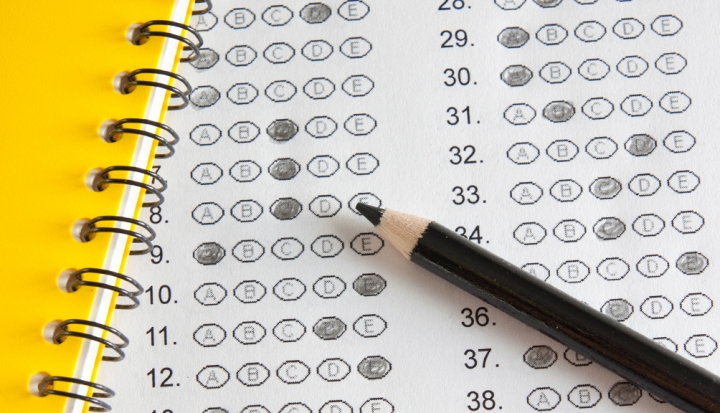A veteran education reporter offers a progress report on whether our education system is meeting its obligation to teach the children well.
“I started my adult life as a teacher, so I know how difficult it is,” says education journalist John Merrow. “There have been times when I have taken over a class while we’re filming and realized how tough it is. Kids started to walk all over me because I had forgotten all the tricks.” So while Merrow has what he calls a “fundamental sympathy” for teachers, he’s also quite comfortable scrutinizing how well they do their jobs—and whether our education system really makes it possible for them to succeed.
Merrow began his career as an education reporter with National Public Radio 40 years ago. Currently education correspondent for the PBS News Hour, Merrow in 1995 founded Learning Matters, a media production company that focuses on schools; its latest production is Rebirth: New Orleans, a film about the transformation of the city’s school system in the wake of Hurricane Katrina. Along the way Merrow also earned a doctorate in education and social policy from the Harvard School of Education.
In this interview with U.S. Catholic, Merrow explains that his role is that of a “sportscaster” in the world of education, chronicling the ideological battles, the grand experiments, the fight for resources. He spends countless hours each year in classrooms in the United States and around the world, analyzing the impact of these struggles on the children of our country—particularly those whose families have no financial means to send them anywhere but a public school.
You’ve been tracking public schools for many years now. How would you describe the state of education in the United States today?
It depends more on your zip code than anything else, unfortunately.
I started following schools back in 1974, so it’s coming up on 40 years. The seminal moment would be 1983 with “A Nation at Risk,” the report produced by an education commission under President Ronald Reagan that referred to “a rising tide of mediocrity” in public education. Since then we’ve had a reform movement that’s been moving along in fits and starts for 30 years.
We took a well-meaning but misguided wrong turn back around 2000 with No Child Left Behind. Just look at the phrasing of that law. The phrase is stolen from the Children’s Defense Fund, which uses the language actively: “Leave No Child Behind.”
The decision to change it into the passive “No Child Left Behind” absolves us of responsibility: “Well, it’s not really my job. I believe no child should be left behind, but it’s not on me.” There was no sense of “What’s our obligation?” The law had the effect of reducing children to their test scores.
How so?
Democrats and Republicans together worked it out and said, “By 2014 we’re all going to be above average,” or whatever Lake Wobegon notion was used. We’ve done a lot of reporting on how you could actually see policies change in districts all over the country as a result of that law.
As soon as you had this decision that “getting over the bar” was what mattered and the resources were limited, education districts said, “We don’t need to worry about these kids who are already doing pretty well.” Well, they did need to worry about those kids. You dehumanize the whole deal right there.
Talent is randomly distributed. Giftedness is not dependent on your parents and where they went to college. In public education—and parochial education as well, I’m sure—many poor kids got their stimulation from coming to school. The well-to-do kids had piano lessons or clarinet lessons, trips to museums and to other countries. But the poor kids got their enrichment at school.
William Sanders, an education scholar and researcher who has done a lot of research on public education in Tennessee, has data indicating that those talented but poor kids regressed toward the mean without the stimulation of their gifted programs.
The law said that states could set their own standards, and they could move the goalposts whenever they wanted. I think that’s how we ended up going to this kind of madness, this test insanity, which is more pronounced now because we no longer trust teachers.
Why don’t we?
When you all were kids, I suspect that your parents trusted your teachers. There were many more very talented women in the teaching force before the all-important social change that opened up opportunities to women.
No one would want to go back to those days, but in those times we trusted teachers. You still find it in some communities where whatever the teacher says is law. In Hispanic communities, I’ve found that to be true.
If the system itself doesn’t trust teachers, it becomes all about verifying. Now we are creating these systems where first, we’re heavily test score dependent, and second, we’re using these test scores to judge whether a teacher did a good job of teaching, and maybe to fire her.
Isn’t there a pushback now to that mistrust of teachers?
There’s a constant pushback. I wrote about this in a book two years ago called The Influence of Teachers, essentially arguing that there are two camps. There are the people who say we need better teachers—if we just had better people, things would be different. There’s another camp that says no, we have plenty of good people, we need to make teaching a better job.
I’m just a sportscaster here. The battle has gotten more bitter. I’m not sure who’s winning. I just think it’s more strident, which is in keeping with the polarization of this country in general.
There are some terrific examples of how to do teaching right, but those require, if not more resources, then a shifting of resources. In a recent piece for the PBS News Hour, one of the people we profiled is a public school art teacher. She has seven classes a day—seven classes a day!—with one 20-minute break. There’s no time between periods to clean up or to set up for the next class.
She’s teaching kindergarten through sixth grade. As a consequence, this poor woman essentially teaches the same activity in each class. Now that may be better than having no art classes at all, but from the point of view of the teacher, is that really teaching? Or is that crowd control?
In contrast, I recently did some reporting in Japan. There, a teacher is virtually guaranteed to have time to go watch colleagues teach so the teacher can get better. Teachers can sit in the back of the room and watch a colleague and then talk with her afterward about what she was doing and why. That’s professional teaching.
Teacher education is maybe the soft underbelly of this whole thing. There’s a wonderful program run by the University of Notre Dame that I spent some time with called the Alliance for Catholic Education (ACE). Their ACE Service through Teaching program is like Teach for America, except that it is much more hands-on. It also includes training over the second summer, when everyone comes back and works through the problems they encountered in their first year.
It sounds like you’re more in the camp of saying we have good teachers, but we need to make teaching a better job.
I do have a fundamental sympathy, but I don’t want to give a free pass to teachers. I think there are men and women who shouldn’t be teaching. We clearly need ways to verify. You can’t trust everyone.
Maybe we ought to treat it like major league baseball: You have standings, but by school. You can judge a school, of course, on how students do on statewide tests. But we could also talk about teacher turnover, teacher attendance, pupil attendance, how many hours of physical education kids have per week, or how many hours of arts classes they have per week.
If you don’t even ask the question, then you’re not holding the people in charge accountable.
Some of the hostility toward teachers at the moment seems to be connected to teachers’ unions.
Teachers’ unions have certainly been in the sights. They rub some people the wrong way. The 2010 documentary Waiting for Superman plays Darth Vader-type music every time that Randi Weingarten, president of the American Federation of Teachers, comes on-screen.
Of course, that’s a deeply flawed, dishonest film, with staged scenes and that sort of thing, but the message was a popular one: Charter schools are the good guy, teachers’ unions are the bad guy. That oversimplification has a lot of appeal for some people.
The facts are that there are some charter schools with unions. The facts are that probably the state with the strongest teachers’ unions is Massachusetts, and its schools are among the best in the country. In right-to-work states where unions are very weak—Mississippi, Louisiana, Alabama—public schools are far worse, if you look at the National Assessment of Educational Progress.
Saying, “It’s the unions” is an easy way to understand why things are so bad. It’s a canard. Yes, to some extent they’ve been part of the problem because they have not said, “If our kids are not learning, we’re not doing a good enough job.” They have paid far too much attention to the protection, care, and feeding of the adults.
You mentioned that zip codes play a big role in education. How does the income level of the zip code affect the quality of a school?
My colleague John Tulenko did a piece for the PBS News Hour earlier this year about a middle school in Portland, Maine. John went up there four times to report on their project-based learning. The teachers together devised a project in which the kids would design and create energy-producing devices.
It’s a brilliant piece. We ended up focusing on two girls who said, “I don’t know how to do this, I can’t speak in public, I’ve never picked up a hammer.” You look at these kids and you know they’re not from a high-income zip code. They’re poor, racially mixed.
You see them change. You see them take risks and fail and get up off the ground and try again. By the last piece, these two girls who said, “I can’t do it” are speaking in public.
You never meet the school principal in John’s report, but she must have been an incredible, enlightened leader. You had teachers who were respected, who were given this opportunity, who were trusted. You had kids who were challenged. One kid creates a brush for washing dishes that generates electricity. I encourage you to go watch that piece because your reaction will be, “Wow, why don’t we do that at my school?”
What prevents us from having this or similar successes being replicated all across the country?
I guess the pessimist side of me thinks that too many of us say, “They’re not my kids. I don’t need to care about them.”
But a huge part of it is attitudinal at the school level, saying, “We’re going to do these things.” Education requires change. I remember following a school reformer many years ago who was trying to change a high school. Her mantra was, “Everybody stays, but everybody changes.”
The glitch in that is, if you don’t change, you don’t stay. What she found out the hard way is that education is not proactive. Education is reactive. It seems like everybody in education knows where the brake is and is willing to use it, but they don’t know where the accelerator is.
Also, the federal government could, it seems to me, use the tax code to affect the distribution of resources. There could be policies that help create the solution for teaching in poorer areas. They could identify beleaguered districts by income and give federal tax breaks to men and women who decide to teach there.
Isn’t poverty the elephant in the living room in education?
Many things can divert us from the fundamental issue that we have a lot of kids who wake up hungry, who go to school hungry, whose health is in jeopardy. To say, “Well, it’s on the teacher to make up for that” is hypocritical. Teachers are not using poverty as an excuse. They’re just saying, “Let’s look at this reality.”
The baseball movie Field of Dreams says, “If you build it, they will come.” Superintendent Paul Vallas used to say that about schools in New Orleans: We’ll build these wonderful schools and the students will come. That’s necessary, but it is not sufficient. They come into school, they’re being abused at home, or they haven’t eaten. They’re in poor health. Things must be done at school to address those issues.
Schools aren’t going to be able to address the issue of substandard housing. But you need that notion of school as a center, a warm center for kids.
About 15 years ago we decided to follow a dozen seventh graders in New York City for a whole year. We called it “Growing Up in the City.” There were a couple of white kids, but most were Hispanic or black. What we found, and maybe it’s not a surprise, is that the traditional support systems were gone. There was no Boys & Girls Club, no Catholic Youth Organization for these kids. Those were not there.
In many cases the adults in the home were not a mom and dad. They might be an aunt or a grandparent. The only two places these kids could turn to were the family—but it was a different kind of family—and the school. It was a striking discovery.
We spent some time with some of the girls who were seventh graders, prepubescent. Through their eyes we got a sense of the predators, 18-year-old young men who would come up and hit on them, try to get their phone number. Who protects those girls? Who tells those girls what to say in that situation? You end up finding out that teachers take on that role, or their parents, or family members.
Going through the city, seeing it through the eyes of the seventh graders—the sexualization of society and the commodification of the body—was just astonishing. I came away thinking, “Wow, we are really not treating our children right.”
How would you evaluate the progress that charter schools have made and where they are today?
A charter school is, of course, a publicly funded but private school. Where they have a high bar and some accountability, you have some decent charter schools. I think somewhere around 8 percent of the kids in the country are now going to charter schools.
But even if all the charter schools are excellent, it is simply not a solution to the problems of public education. It’s not a rising tide lifting all boats—it’s one boat. God bless the 100 or 200 kids who get in that boat. But we need some other approach, it seems to me.
Yet aren’t voters notoriously stingy about allotting money for public education?
The best advertisement for public education is the kids. Public educators ought to be thinking of ways to help the 75 or 80 percent of households that don’t have a direct interest in public education to understand what’s going on in schools.
For example, in middle school, why not have three seventh graders go out and do video interviews with the woman who runs the clothing shop on the block, or the guy who runs the deli? Most of those folks don’t have any kids in school. The students could do an interview and a little video profile. The kids learn a whole set of social skills: how you ask questions, how you listen carefully, how you follow up. And this woman in her shop will say, “I didn’t know they did stuff like this in school! Wow!” That way, you get a convert.
A lot of people think that we’re over-testing kids with standardized tests. How much is too much?
The spouse of one of my colleagues is teaching at a school in the Bronx. She told me that they spend most of their time either being tested or getting ready to take tests.
If I were a principal or a superintendent, I’d assemble a team and I’d work out some rule, such as for every week of test prep that this school decides to do, it must have at least two weeks of project-based learning. In other words, make some trade-offs.
There ought to be some rule that you shouldn’t have more than one test whose results you don’t get for six months, because they won’t do you any good. I remember being in one high school where the math teachers got together and agreed that during this week they would be teaching, say, fractions, and they would have short daily assessments that all the kids would take.
They would then be able to run those through a machine, get the results, and meet the next day. They’d be able to see that half of the kids didn’t get it, but Scott’s kids did. Then the math chair would say, “Scott, would you show us how you taught it?”
You get the results, then you act upon the results. If, on the other hand, you spend two weeks on test prep, that’s a different story.
What are your thoughts on the Obama administration’s Race to the Top initiative?
To me, the lesson of No Child Left Behind was that there is not enough wisdom in Washington to run public schools. The Obama administration is trying a slightly different playbook, but essentially it’s the same goal: to take this 7 or 8 percent of resources that the feds contribute to public education and wag the dog.
California has been flirting with not giving the mandated tests; the administration has said they can do that, but they’ll lose a large chunk of change.
It doesn’t seem likely that there’ll be a flat-out rebellion against Race to the Top. There wasn’t a flat-out rebellion against No Child Left Behind. It was an awareness that it was just plain stupid, that states were gaming the system. The idea that “Everybody will be at a proficient level by 2014” was impossible. It was only when they had to recognize how absurd it was that they adopted a new approach.
Race to the Top, it seems to me, is still the folks in Washington making some pretty fundamental rules. As I say often, No Child Left Behind showed us that Washington didn’t know enough. What the Obama administration is saying is, “We learned from that and now we do know enough.”
Now we have this possibly wonderful thing coming in called the Common Core standards. These standards say kids should be able to speak persuasively; they should be able to work cooperatively.
Hasn’t there been some opposition to the Common Core?
The opposition is coming from both left and right. It takes us back to William Butler Yeats: “Things fall apart, the center cannot hold.” This is going to be a test of whether there is a center.
One way to think about the Common Core is that it does raise standards. We have such low expectations for kids that raising standards has to be a good thing. On another level, this approach has not been tested. It is a little bit like testing the temperature of the water with both feet. On balance, it’s a good idea.
I’ve been in classrooms where the teachers are just teaching differently. We did a piece for the PBS News Hour—a school teaching the Common Core in Brooklyn, where kids are having a debate on free speech. There are kids representing different teams, but others on the team can pass a note to their representative. The teacher is judging the teamwork, judging who speaks persuasively for, or against, free speech.
Those kids were really engaged. If they do a lot of that, that would be really great. If we can stay focused on raising those standards and asking more from our kids, it could work well.
What would you do if you had the job of U.S. Education Secretary Arne Duncan?
I hate questions like that. If I were in Arne Duncan’s shoes, the one thing I’d do is get the federal government out of the teacher accountability business. It’s not really the federal government’s job to hold teachers accountable, and that’s a big part of Race to the Top. If you can’t trust the local and state governments to hold teachers accountable, then the game is over.
Get the federal government out of holding teachers accountable, and focus the energy on speeding up the transition that is now going on: where senior year in high school is going to disappear and be replaced by schooling opportunities for 3- and 4-year-olds.
Right now, we have hundreds of thousands of high school seniors taking college classes, which is great. Otherwise high school senior year is a travesty for so many kids.
The federal government ought to be devoting more resources to early childhood education, to help states create quality preschool for all kids. They should figure out ways to support early childhood education for all 3-year-olds whose parents want it.
I would also do far more to spotlight what is working and to right the wrongs in our education system.
This article appeared in the February 2014 issue of U.S. Catholic (Vol. 79, No. 2, pages 18-22).
Image: StockVault/GeoffreyWhiteway















Add comment